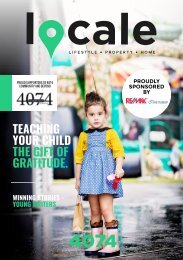Locale Hub 4300 - Issue 1
You also want an ePaper? Increase the reach of your titles
YUMPU automatically turns print PDFs into web optimized ePapers that Google loves.
ACHIEVING FULL<br />
POTENTIAL<br />
The science of child<br />
resiliency explained<br />
TEN<br />
SUPERFOODS<br />
To benifit your family<br />
PROUDLY SPONSORED BY
PROUDLY<br />
SPONSORED<br />
BY
<strong>Issue</strong> 1 | September 2016<br />
Advertising Enquiries:<br />
sales@locale.com.au<br />
Published by:<br />
Millennia Publishing<br />
Distributed by:<br />
Millennia Publishing<br />
Designed by:<br />
Millennia Publishing<br />
ALL RIGHTS RESERVED<br />
Reference to any specific commercial product,<br />
process, or services by trade name, trademark,<br />
manufacturer, or otherwise, does not constitute<br />
or imply its endorsement or recommendation<br />
by Millennia Global.<br />
Links outside of <strong>Locale</strong> Magazine are provided<br />
for user convenience and do not constitute<br />
or imply endorsement, recommendation, or<br />
favouring by Millennia Global.<br />
No person, organization or party can copy<br />
or re-produce the content on this site and/<br />
or magazine or any part of this publication<br />
without a written consent from the<br />
editors’ panel and the author of the content,<br />
as applicable. The publisher, Millennia Global,<br />
authors and contributors reserve their rights<br />
with regards to copyright of their work.
Notes from the Editor<br />
• Selling your home<br />
• What’s On in <strong>4300</strong><br />
Hello and welcome to the first issue<br />
of <strong>Locale</strong> Magazine <strong>4300</strong>! We are<br />
excited to present the first issue with<br />
articles about our local businesses,<br />
people and area. The weather seems<br />
to be brightening and warming up<br />
now and spring is upon us. In this<br />
edition we have:<br />
• Raising resilient kids<br />
• Super foods for your family<br />
• Assisting teenagers through life’s<br />
challenges<br />
• Renovating for the best profit<br />
...along with so much more. This is your magazine, dedicated to<br />
showcasing your businesses and events and always focusing on<br />
creating a local community.<br />
Our major sponsor Aussie Springfield Central Mortgage Broker<br />
continues to work with <strong>Locale</strong> Magazine <strong>4300</strong> to support our<br />
local community and see it thrive. It is outstanding to work<br />
together with our partner to produce this project.<br />
If you have any content you would like to include in our<br />
magazine <strong>4300</strong> please head to www.localehub<strong>4300</strong>.com/share<br />
magazine and fill in the form to send us your content.<br />
Thank you for taking the time to read <strong>Locale</strong> Magazine. Please<br />
support the businesses that are making <strong>Locale</strong> <strong>Hub</strong> possible. :)<br />
“Life is not<br />
about waiting<br />
for the storm<br />
to pass,<br />
it’s about<br />
learning to<br />
dance in the<br />
rain”<br />
Suzanne<br />
About our Editor: Suzanne is a qualified journalist with more than 18 years<br />
experience. She has written for many publications over this time including being<br />
a Special Industry Reporter for Hotel Motel and Resort News and AMG Magazine<br />
for two years. Some of the publications she has worked for include: The New<br />
Internationalist, The Sydney Morning Herald, The Big <strong>Issue</strong>, Sportswoman, The<br />
Review Independent Monthly, AMG Magazine, Building Australia, Boardwalk<br />
Magazine, Australian Property Investor, Hotspotting.com.au amongst others. In<br />
addition to this Suzanne also worked in Media Relations, Corporate Communications<br />
and tutored Journalism/Writing in the Creative Industries at QUT in<br />
Brisbane.<br />
05
Simple Steak & Chips<br />
Ingredients<br />
• 600g medium-sized potatoes<br />
• sunflower oil for frying<br />
• 2 x 200g/8oz beef steaks<br />
• 2 handfuls mixed leaves<br />
• Your choice of dressing to serve<br />
• 50g butter, softened<br />
• Small handful parsley leaves, finely<br />
chopped<br />
• 1 small garlic clove, minced (optional)<br />
• Small squeeze lemon juice<br />
Method<br />
1. First make the butter: mash all the ingredients<br />
together with lots of cracked black pepper.<br />
Pat the butter flat between cling wrap and<br />
put in the fridge or freezer to harden.<br />
2. Cut the potatoes into proportioned chips,<br />
rinse under hot water, then dry on a tea towel.<br />
Place the chips into a deep saucepan and then<br />
just cover with cold oil. Place the pan on medium<br />
heat, bring the oil to a simmer and give<br />
the chips a stir with a wooden spoon. Increase<br />
the heat so the oil bubbles really quickly and<br />
fry the chips, stirring occasionally to prevent<br />
sticking until crisp and golden – the whole<br />
process should take 15-20 mins. When they are<br />
finished, scoop out with a large spoon onto a<br />
plate lined with kitchen paper and set aside.<br />
3. Meanwhile, heat the frying pan until smoking<br />
hot. Season the steaks with salt and pepper<br />
and rub with a little oil – how you cook your<br />
steak depends on the cut you have chosen and<br />
its thickness. Just before lifting the steaks off<br />
the griddle pan, place half the butter on top<br />
of each. Serve the steaks with the chips, some<br />
mixed leaves and a tasty dressing.
Achieving Full Potential<br />
- The Science of Child Resiliency Explained<br />
By Sue Davey<br />
Author. Speaker. Mentor. Philanthropist.CEO &<br />
Founder of Sue Davey International, Mastermind<br />
Success Coaching, Brainy Child Education<br />
Each person handles adversity and<br />
challenges differently, that much is known,<br />
but what is it that we know about the<br />
factors that come into play when it comes<br />
to developing resiliency? Why is it that<br />
some children are able to respond well to<br />
challenging situations and thrive, and how<br />
can we help children develop resilience?<br />
In a three-part video series by the Centre on<br />
The Developing Child at Harvard University,<br />
they offered an overview of resilience, the<br />
science behind overcoming adversity as well<br />
as the factors that build resilience.<br />
The first video discussed resilience as a<br />
concept and is defined as a good outcome<br />
in the face of adversity.<br />
“The extent to which we are able to build<br />
capacities in all children early in their lives. To<br />
be able to deal with whatever bumps in the<br />
road or major obstacles may be coming down<br />
the track, that’s an investment in building<br />
strong human capital and healthy productive<br />
adults,” said Jack P. Shonkoff, M.D. Of the<br />
Center on the Developing Child at Harvard<br />
University.<br />
Not all children encounter the same amount of<br />
adversity, with some being exposed to more<br />
difficult life experiences than others. Some<br />
examples include mental illness, difficult family<br />
environment, poverty, struggling academic<br />
institution or violence being some realities<br />
some children come in contact with at an early<br />
age.
Resilience is the ability, skills or qualities of<br />
positive adaptation that enables one to master<br />
themselves and their reactions to remain<br />
balanced in spite of adversity.<br />
The development of resiliency isn’t immediate,<br />
it’s built over time and is affected by not only<br />
the person’s character but also dependent on<br />
the interactive process with one’s environment.<br />
A child’s level of resilience is a continuous<br />
balance between the positive and negative<br />
outcomes occurring in their life with respect to<br />
one’s genes and personality, which results from<br />
their reality and daily circumstances (i.e. health,<br />
family life, financial stability, etc.).<br />
As a child’s positive experiences accumulate,<br />
they learn coping skills that aid in stress<br />
management making an emphasis on positive<br />
outcomes easier. At the heart of the process is<br />
the supportive network and relationships they<br />
have, particularly the family, caregivers and<br />
larger community, who play a supportive role<br />
and contribute to child development.<br />
Positive interactions enable children to build<br />
coping skills and adaptive abilities like how<br />
to self-soothe, delay gratification, regulate<br />
behaviour and more. It is during stressful times<br />
that people tap into the lessons learned that<br />
allow you to manage challenges.<br />
The key to building resilience in children is<br />
to equip community members with the right<br />
skills, tools and support mechanisms for more<br />
positive outcomes for children. Below are some<br />
important steps factors to consider, including<br />
quality childcare, parental coaching, stronger<br />
schools and much more.<br />
For parents who want to build resilience in<br />
young children, below are some things we can<br />
do to provide support in young children. These<br />
things include:<br />
1 ∙Don’t over accommodate∙<br />
We live in a world where parents want to give<br />
their children comfort and protection. It’s<br />
important to realize that over protection fuels<br />
anxiety and fear. Eliminating all risk and giving<br />
all comforts rob children of learning resiliency.<br />
2 ∙Make strong connections∙<br />
Encourage children to connect with<br />
others and teach basic skills of empathy<br />
and understanding. This will foster the<br />
establishment of a strong family and social<br />
network that will provide support for them<br />
during difficult times.<br />
3 ∙Empower through helping∙<br />
Children will benefit from helping others. By<br />
engaging children in age-appropriate goodwill<br />
activities, they will experience the benefits<br />
of helping others and asking for help when<br />
necessary.<br />
4 ∙Nurture a positive sense of self∙<br />
Help your child appreciate themselves and<br />
those around them. Make every opportunity of<br />
strength a lesson that shows your child they are<br />
able to handle difficult situations. This will build<br />
character and strength that will aid in handling<br />
future challenges.<br />
5 ∙Maintain a routine∙<br />
Sticking to a routine can be a source of comfort<br />
the predictability and structure offers security,<br />
especially in younger children. Encourage your<br />
child to develop their own routines and coach<br />
them on how to maintain flexibility within that<br />
structure.<br />
6 ∙Accept that change is inevitable∙<br />
While structures are important, children need<br />
to know that life will always have unexpected<br />
turns. Change can often be scary but when a<br />
child sees that it is part of life and offers various<br />
opportunities, children will be much more<br />
adaptive with stronger coping skills.<br />
By promoting resilience in children, despite<br />
the odds, more children can grow up to be<br />
balanced and productive members of society.<br />
With the right foundation, children grow up<br />
to have healthier and happier relationships,<br />
become more successful in the different<br />
aspects of their lives. Resilience is one of the<br />
factors in helping children to reach their full<br />
potential.<br />
The importance of resilience is discussed<br />
in much more detail in my upcoming book,<br />
“Reeboot Your Mind”.
LOCATING THE RIGHT HOME<br />
WITHOUT WASTING TIME<br />
In the market for a new home? Eager to hit the streets and spend your weekends looking at open<br />
inspections? Here a few tips to help be more efficient in your search so that some of your weekend<br />
can be relaxing.<br />
BUDGET SAVVY<br />
Before you even consider leaving the front door to search for a new property know how much<br />
you can spend. This prior knowledge will make searching for a new home that much more<br />
efficient as you won’t be wasting time looking at properties that are just a tad too much for your<br />
budget.<br />
BE PREPARED<br />
In an effort to not arrive at an inspection to find out the house is already under contract or the<br />
home has sold earlier that week make it a priority to ring the agent ahead of time for the homes<br />
you intend to visit. Ask as many questions as possible as you might also find out interesting<br />
information about the state of the sale and how eager the owners are willing to sell.
LOCATION, LOCATION, LOCATION<br />
Before you venture forth get online to google maps and have a look where each property is<br />
situated. This will give you valuable information as to whether it is close to main roads, leisure<br />
centres, schools and shops etc. This may save you a lot of time if you find the house is just too far<br />
from your essential requirements so it won’t be considered.<br />
MARKET RESEARCH<br />
Know your market before you get out there. Do as much research as possible on locations and<br />
the current market state. This can save you time by getting you clear on what to expect as you<br />
visit houses and talk to agents. If you have been diligent you may also find that some house<br />
prices have dropped in your area leading you to a better deal.<br />
REALITY CHECK<br />
Take a list of your must haves with you. Make sure the properties you look at buying meet these<br />
needs. At the same time remain realistic about what the property has to offer in the long term as<br />
adjustments in style preferences can always be changed with a coat of paint or new flooring.
Ten Super-Foods to Benefit Your Family<br />
Parents know they should be giving their children a balanced diet, but what<br />
exactly is healthy for our families? How can you make sure that your child<br />
is getting all the nutrients and vitamins they need?<br />
Children need even more nutrition than adults and they need healthy fats<br />
to help their mind and body to grow and develop.<br />
Often parents will choose the quickest and easiest options for meals, that<br />
will be consumed without complaint, which is understandable. But really<br />
we should be trying to provide the foods that provide the most powerful<br />
nutritional punch?<br />
The following are ‘Super-Foods’ that can easily be incorporated into your<br />
family’s diet and will inject the vitamins and minerals that they need in a<br />
day:<br />
• Eggs: Eggs are underestimated but they provide a protein power<br />
injection and are one of the few foods that naturally contain vitamin<br />
D, which assists the body to absorb calcium. Eating protein for<br />
breakfast helps kids to satisfy hunger for longer and prevents mid<br />
morning hunger pangs.
• Oatmeal: Whole grain oatmeal is fiber-rich, and digests slowly,<br />
providing kids with a constant stream of energy.<br />
• Blueberries: Packed with antioxidants, blueberries can be a good<br />
shield against some cancers and other diseases.<br />
• Sweet potatoes: This is a versatile vegetable that can be<br />
seamlessly incorporated into any meal. Loaded with beta carotene,<br />
vitamin E, vitamin B6, potassium and iron, they provide a nutritional<br />
boost.<br />
• Avocados: These are a superb source of monounsaturated or ‘good’<br />
fats which assist in aiding growth and development in children.<br />
• Broccoli: This green goodness contains many vitamins and minerals<br />
and helps protect against cell damage and boosts eyesight in kids.<br />
• Yogurt: Kids love yoghurt, and it is a great snack that is full of<br />
calcium, protein, vitamin B, zinc and phosphorus.<br />
• Tuna and salmon: Some kids won’t try tuna or salmon but if<br />
you can convince them, it’s worth it as it’s completely packed with<br />
Omega-3 which is a healthy fat to help brain development and sets<br />
your child up for a healthy heart.<br />
• Beans and legumes: There are many types of beans available so<br />
the chances your child will like one type or another are high. Beans<br />
provide an excecllent source of fiber and promote good blood sugar<br />
by releasing glucose slowly which helps in stabalising mood and<br />
energy levels.<br />
• Seaweed: Packed with loads of amino acids, vitamins and minerals<br />
seaweed is said to be one of the most nutritious foods on the planet –<br />
perfect for growing children’s brains and bodies!<br />
Try to incorporate some of these foods into your family’s daily food intake,<br />
this will help your children to develop good habits as they grow older. It will<br />
also help your children’s young bodies to gain all the vitamins, minerals and<br />
energy they need to develop and function at an optimum level.
What Parents Need to Know about Aussie Teenagers:<br />
10 ways to help your kids thrive<br />
Pornography, peer pressure, perfectionism<br />
to conform to social media, split families,<br />
self-harm, parental pressure to succeed,<br />
cyber bullying and gaming are all concerns of<br />
teenagers today, according to the ABC 4Corners<br />
documentary Our Kids.<br />
In a telling episode, Australian kids from the age of 12<br />
year to 19 years shared a glimpse of their inner world<br />
and what their hopes, fears and dreams are for the<br />
future.<br />
While many of the concerns are not dissimilar to<br />
previous generation of teenagers, the explosion<br />
of social media has expanded the horizons of our<br />
teenagers and is having a dire impact on their selfimage,<br />
increased exposure to world events such as<br />
terrorism and over use of technology.<br />
Cyber bullying is wreaking havoc with teenage girls as<br />
well as the pressure to conform to the perfection that<br />
girls are seeing their friends on Instagram, Snapchat<br />
or Tumblr. A twelve year old girl in the program told<br />
of her need to belong to the ‘in group’ and used social<br />
media to compare herself to others – to make sure she<br />
had the latest white converse, the triangle bikini and<br />
Marc Jacob jeans and watch.<br />
Another concern for teenagers was the added pressure<br />
of parents wanting their kids to do well at school.<br />
These kids were concerned that their parents are<br />
putting huge, unnecessary pressure on kids to succeed<br />
at school as well as to participate in an ever increasing<br />
amount of extracurricular activities and tutoring. One<br />
girl talked about how she was in the top maths group<br />
but her mum doubted her. ‘I’m going to fail every test<br />
according to mum’.<br />
An alarming statistic in the program revealed that 30<br />
per cent of 11-17 year old boys spend up to 3 hours<br />
a day gaming – more on weekends and it is affecting<br />
boys ability to use their time well. One boy said ‘I don’t<br />
have time for homework’. They are mostly playing<br />
the game ‘call of duty’ against each other in virtual<br />
online worlds and while gaming can have positive<br />
ramifications to help kids think outside the box,<br />
problem solve and build a community, there needs<br />
to be strong boundaries and rules in place from the<br />
parents to balance it with other activities, including<br />
homework and sport.<br />
The major concern for this age group, especially<br />
among girls is the widespread use of self-harm. Selfharm<br />
is dubbed the ‘new anorexia’ and scarily enough<br />
this age group do not see it as dysfunctional because<br />
it is so rife. Around 135,000 kids have self-harmed this<br />
past year. It is strongly related to poor mental health<br />
and can take its toll on all aspects of the teenager’s life.<br />
Mental health in our teenagers today is at an all-time<br />
low with one in four teens currently have a mental<br />
health condition (including anxiety, depression and<br />
substance abuse) and a quarter also saying they are<br />
unhappy with their lives.<br />
Access to pornography is altering the view boys have<br />
of girls. By the age of 10, every boy will have seen porn<br />
online and this is impacting on sexual relationships<br />
and intimacy between boys and girls.<br />
The common thread throughout the episode that<br />
relieved stresses and pressures in teenager’s lives was<br />
physical activity and strong relationships.<br />
So what role can parents play in the lives<br />
of their children to ensure they thrive<br />
though the teenage years?<br />
1 Start early<br />
By the time your child is a teenager, you have already<br />
sown the seeds of independence, love, trust, respect,<br />
good mental health, resilience, confidence, self-esteem<br />
and habits around technology. You have already<br />
built your relationship and while none of these are<br />
irreparable with a teenagers, they are easier to develop<br />
from the moment our children are born, than to<br />
suddenly input when your children are teenagers.<br />
2 Build a solid relationship from the start<br />
Extensive and widespread research shows that<br />
building a strong parent-child bond early is the<br />
number one factor to raising a resilient child. When a<br />
child feels loved, nurtured and a sense of significance<br />
and belonging from just one adult (ideally a parent<br />
or parent figure), they have stronger mechanisms<br />
to bounce back from adverse situations than<br />
their counterparts who have formed negative or<br />
no relationships with an adult and to make good<br />
decisions. The relationship starts the very moment you<br />
hold your child in your arms and it looks at you. Right<br />
from that moment, you are forming an important bond<br />
that will last a lifetime. Like any relationship, it needs<br />
to be nurtured and effort needs to be fed into it to<br />
make it work. One on one time is important, speaking<br />
respectfully, building the relationships on love and<br />
cuddles, creating micro moments of connection and<br />
acknowledging how special your child is to you, are all<br />
important in building a strong relationships.<br />
3 Set clear boundaries and expectations<br />
Just like adults, children are creatures of habit and<br />
love to follow rules when they are young. If you can
set clear boundaries and expectations early, they<br />
will know exactly where they stand with you and<br />
in their environment. You will help them make<br />
sense of the world around them, form good habits<br />
and ideally make good choices when faced with<br />
everyday problems. When you set the boundaries and<br />
expectations, be consistent. Follow through on what<br />
you say and let your child feel safe and secure in their<br />
environment with you.<br />
4 Be the role model<br />
As a parent, you are your child’s first role model. If<br />
you have watched your children closely for a few<br />
hours or listened to them speak, you will hear and see<br />
snippets of your most common sayings or mannerism<br />
come out in their play time or voice as they mimic<br />
you. Provide your child with an environment and role<br />
model that is upbeat and gives your child hope and<br />
a positive attitude to move through their day. Young<br />
children react to whatever mood or state of mind you<br />
are in. If you are always stressed and in a hurry, they<br />
will pick up the vibe and develop a similar habit. Take<br />
time to stop and be with your kids. Have fun with<br />
them at the park or at the beach. Take them on nature<br />
walks. Think of who you needed around you when<br />
you were a child and be that person.<br />
5 Meet children in the moment<br />
Children live in the moment so meet them there.<br />
Don’t overload them with your own stresses and<br />
worries we carry with us as adults, both past and<br />
present. A child’s biggest concern in their day are<br />
generally meeting their own basic needs – food,<br />
water, sleep, safety and love. Meet your kids there.<br />
6 Don’t over catastrophize the situation<br />
The part of the child’s brain that deals with emotions<br />
and rational decision making is underdeveloped.<br />
The prefrontal cortex doesn’t fully develop until<br />
the age of 22. However, as adults we already have<br />
a fully functioning rational brain. We need to use<br />
our skills to calm a situation down and don’t over<br />
catastrophize it. Because of an underdeveloped brain<br />
as a child, their response is irrational and so through<br />
words, actions and role modelling we can use our<br />
rational brain to invoke calm and coping strategies<br />
for certain situations that doesn’t result in a full blown<br />
catastrophe.<br />
7 Let children experience disappointment<br />
Our natural propensity as a parent is the ‘fix’. However,<br />
if we continue to fix every disappointment our<br />
child faces, they are not going to develop their own<br />
strategies to cope with the ups and downs of life and<br />
the disappointment that results from that. So ‘be’ with<br />
your child when they experience disappointment and<br />
tell them how much is sux that they didn’t get into<br />
the cricket team or the choir. Problem solve ways to<br />
help them get over it.<br />
8 Recognise emotions and strategies to deal<br />
with them<br />
By helping a child recognise their own emotions and<br />
develop strategies to deal with them, we are allowing<br />
them to again navigate the ups and downs of life. The<br />
big emotions that press parent’s buttons are anger,<br />
frustration and sadness that generally result in an<br />
emotional outburst in some form from our child. Let<br />
your child experience these emotions, name them<br />
and put strategies in place to deal with them. Assure<br />
your child it is OK if they feel these emotions as long<br />
as they know how to move on from them.<br />
9 Shape a positive inner critic<br />
For good mental health, we need to help our children<br />
develop a positive inner critic. They need to be selfconfident<br />
and self-assured to back themselves in<br />
difficult situations and to make good choices. By<br />
teaching our children to love themselves and be kind<br />
to themselves, we are setting them up for being able<br />
to deal with setbacks, making mistakes and failure. To<br />
encourage self-confidence, our children need to feel<br />
a sense of significance. Let them perform that dance<br />
concert with bad dance moves and terrible music. Let<br />
them experience new things and take risks. Let them<br />
say no and assert themselves and learn from that<br />
experience. And use positive self-talk yourself – don’t<br />
criticize yourself in front of your children.<br />
10 Discipline with respect and love<br />
Every children will need discipline at some point and<br />
some more than others. When you are disciplining<br />
your child, remember it is the behaviour you are<br />
correcting – not the child. Don’t shame them or<br />
criticize them as a person. Speak to your child like you<br />
would talk to your best friend or your work colleague<br />
– with respect. Give lots of cuddles and use discipline<br />
as a teachable moment to learn from rather than a<br />
time to berate or shame.<br />
Anna Partridge is a Parent Education, School<br />
Teacher and Mother to 3 kids. She is passionate<br />
about working with families to help them raise<br />
confident and resilient children.<br />
http://www.annapartridge.com<br />
About Anna:<br />
Anna Partridge is<br />
a certified Positive<br />
Discipline Parent<br />
Educator, a school<br />
teacher and a mother to three highly<br />
spirited, beautiful children. She loves<br />
nothing more than helping parents raise<br />
resilient and confident children, build strong<br />
and connected family relationships and<br />
strive for calm, fun and happy families.<br />
http: /annapartridge.com/
What’s<br />
On<br />
Wicked - The untold story of the witches of Oz<br />
Excitement is in the air! Wicked is the next megahit<br />
musical released for community theatre, as was<br />
Phantom of the Opera (2014) and Mary Poppins (2015).<br />
Simon Gallaher headed the Wicked Audition Panel.<br />
Wicked tells the incredible untold story of an unlikely<br />
but profound friendship between two girls who first<br />
meet as sorcery students at Shiz University: the blonde<br />
and very popular Glinda and a misunderstood green<br />
girl named Elphaba.<br />
Following an encounter with The Wonderful Wizard<br />
of Oz, their friendship reaches a crossroad and their<br />
lives take very different paths. Glinda’s unflinching<br />
desire for popularity sees her seduced by power while<br />
Elphaba’s determination to remain true to herself, and<br />
to those around her, will have unexpected and shocking<br />
consequences for her future.<br />
Their extraordinary adventures in Oz will ultimately<br />
see them fulfil their destinies as Glinda the Good and<br />
Elphaba the Wicked Witch of the West.<br />
Event Dates & Times:<br />
Friday 9, 10, 16, 17 September | 7.30 pm<br />
Sunday 11 & 18 September | 1.30 pm<br />
Cost: Adult $60.00<br />
Concession $55.00<br />
Child (13 years & under) $30.00<br />
Family (2 adults & 2 children) $160.00<br />
Group 6+ $56.00<br />
Group 10+ $52.00<br />
Gala Fashion Evening Launch<br />
When: Friday September 23, 2016.<br />
Join us at the Gala Fashion Evening Launch on Friday<br />
23 September to view some of Queensland’s brightest<br />
lights of fashion, including Hunt + Kelly, Dogstar, Living<br />
Silk, Tengdahl Australia, and many more.<br />
This sophisticated evening features the best of<br />
international designer labels, national and local<br />
fashion designs, and the hottest new Spring/Summer<br />
collections. We also take a glimpse into the artistic<br />
world of emerging hair and fashion designs with the<br />
announcement of the PFAFF Student and ASPIRE<br />
fashion design awards, and the Session Style Hair<br />
Awards.<br />
Now in its fifth year, the Ipswich Fashion Festival has<br />
become an annual celebration of fashion, beauty, and<br />
creativity blending the contemporary, exotic and avantgarde<br />
– all draped within an evening of complimentary<br />
champagne, canapés, and<br />
spectacular entertainment by the amazing Suzie G.<br />
Be ready for the romantic, dramatic, and seductive!<br />
Cost: All tickets $35.00<br />
Group 10+ $30.00<br />
How to get there:<br />
Please visit Translink as your guide to public transport<br />
timetables, fares and accessible transport.<br />
Who should attend: All ages family event.<br />
How to get there: For all public transport options to<br />
this venue, please visit Translink.
Handy<br />
Home<br />
Hacks<br />
∙Lengthening Vegetables Lifespan∙<br />
If vegetables become cheaper in price due to ageing,<br />
you should stock up. As soon as you have your produce<br />
at home slice and dice it and then place it in freezer<br />
bags. If you immediately freeze it then you will halt the<br />
ageing process. Plus, you’ll have ready-to-use frozen<br />
vegetables for whenever you want to make a stew or<br />
sauce<br />
∙Storing asparagus∙<br />
We all have experienced vegetables getting soft and<br />
limp inside the bottom drawer of the fridge. How do<br />
we keep vegetables alive longer? Place a vegetable like<br />
asparagus upright in a jar, or cup in your fridge. Remove<br />
the bottoms of the storks, put them together into<br />
bunches and soak in a few centimetres of water to ensure<br />
they retain their freshness.<br />
∙Homemade frozen yoghurt∙<br />
It’s hard to beat a homemade healthy yoghurt dessert.<br />
But who has the time to spend churning and turning to<br />
produce the results? To achieve the same result, buy<br />
a single-serve size of creamy yoghurt and a packet of<br />
wooden sticks. Don’t take the lid off, instead, pierce it in<br />
the centre with the stick. Next, put it in the freezer and<br />
then when the weather’s warmer and you’re after a treat,<br />
remove the lid and ease the now frozen yoghurt out of<br />
the container.<br />
∙Watermelon lollies∙<br />
Eating watermelon can be difficult at best. Watermelon is<br />
awkward to eat, big and difficult to move around on your<br />
chopping board, let alone cut. Then the fruit’s natural<br />
juice all over you. Rather than slicing the melon into<br />
traditional slices, cut it in half, then slice into strips and<br />
stick in a toothpick.<br />
∙Keep bananas ripe for longer∙<br />
Wrap your bananas with plastic cling wrap on their ends<br />
and they will last days longer.<br />
∙Delicious homemade iced coffee∙<br />
Enjoy a glass of homemade iced coffee that’s better than<br />
any store-bought caffeine kick. The trick to making good<br />
iced coffee is preparing frozen coffee cubes in an ice<br />
tray in advance. When needed you can add the cubes to<br />
ensure your coffee stays cold, then it keeps its strength<br />
rather than be watered down.<br />
∙Removing strawberry tops∙<br />
We always tend to waste a lot of strawberries by<br />
chopping off their stems.<br />
Instead of using a knife, which doesn’t get close enough<br />
to removing only the stork, use a straw. Pierce the base<br />
of the berry with the straw, by pushing it through you<br />
will see only the unwanted stem is removed from the<br />
strawberry. It is not messy and quick as well.
Renovating<br />
for profit<br />
means<br />
adding value<br />
Your home in most cases is your primary asset.<br />
If you have lived in your home for a while, have<br />
you considered what value you can add to your<br />
home asset by renovating? You do not know<br />
what tomorrow may bring so having your home<br />
made “Sale Ready Now” will give you the best<br />
investment return. Here are 10 tips to consider:<br />
1. Research what is happening around<br />
you<br />
Talk to your local real estate agent, in 4074 Remax<br />
Innovation will provide you with an idea of the<br />
current sale price of your home and let you know<br />
what people are looking for in a home in your<br />
area. They visit local homes all the time and know<br />
what is going on. It’s important to learn what is<br />
going to add value for your style of home, where<br />
you are located and in the current market. If you<br />
make alterations that don’t fit your area this will not<br />
provide success for you, no matter how fancy they<br />
are. Understanding key suburb and property facts is<br />
an integral part of this.<br />
2. Look at your property through the<br />
eyes of a potential buyer<br />
Be very critical of your current home and look at key<br />
things, for example:<br />
Street appeal, how does your property look from<br />
the street? Does the garden need a make-over?<br />
Is the roof in good condition and clean? Is the<br />
paintwork in good condition and up with the<br />
current style? Do you have worn paintwork and<br />
substandard landscaping and outdated outdoor<br />
areas? Make sure your interiors are also up to date<br />
in style and with good essential qualities.<br />
The key to getting a return on a renovation<br />
investment is to spend as little as you can to deliver<br />
maximum impact. Talk to Handy Hands Carpentry<br />
about an exterior evaluation, they have years of<br />
experience adding value for impact at the lowest<br />
investment.<br />
3 It’s not about your own taste<br />
To make money, you need to think about your<br />
target audience rather than your own tastes. Keep<br />
your designs simple and current and neutral, but<br />
not personal.<br />
4 Strict budgeting<br />
• If you spend beyond your budget you can<br />
experience cash flow issues, you may have<br />
disgruntled suppliers, not to mention it may destroy<br />
morale and cause trouble. Employing the services<br />
of a professional valuer can help you accurately<br />
estimate expenses and devise a disciplined budget.<br />
Aim to double what you spend as your end game,<br />
and always add leeway for unpredictable situations.<br />
• Analyse the potential profit of the property and<br />
make sure the return on your investment is going<br />
to be worth your initial costs. Be careful of overcapitalising,<br />
this is what happens when the cost of<br />
your renovation outweighs the market value that<br />
may be added to your investment property.
5. Simplicity is always best<br />
There are many small, inexpensive improvements<br />
you can do that can make a huge difference to<br />
your property’s overall value. A fresh coat of paint,<br />
new light fittings, new bathroom fixtures, door and<br />
window handles can all assist to raise your asking<br />
price for sale. Renovating a garden or outdoor<br />
space can instantly change a properties appeal<br />
6 Your agent is a valuable friend<br />
Jan & Allen from Remax Innovation will give you<br />
some good local knowledge about what people<br />
are looking for but can also advise you as to what<br />
you could do to your property to maximise the<br />
price and increase the chance of a sale. Should you<br />
choose to sell your renovated property they will<br />
connect you with a network of potential buyers<br />
7. Partner with professionals<br />
Having one professional organisation such as<br />
Handy Hands Carpentry to pull together the<br />
important trades services needed to successfully<br />
complete a renovation will save you time and<br />
money. They will coordinate all the necessary<br />
elements of the job including; painters, plumbers,<br />
bricklayers, pavers, tilers and landscapers in the<br />
right order to smoothly and painlessly create a<br />
renovation you will be proud of and that will attract<br />
potential buyers.<br />
8. Add space<br />
want a good amount of space! Attraction and<br />
atmosphere is easily created by enlarging or adding<br />
additional rooms. If your house already has large<br />
areas, consider creating new rooms from this space,<br />
especially if it adds a new bathroom or bedroom.<br />
9. Never place an unfinished property<br />
on the market<br />
Potential buyers wouldn’t have known if you<br />
intended to do certain things if they weren’t started,<br />
but it will not create a good impression if you have<br />
an unfinished bathroom, a half finished deck and<br />
kitchens without appliances.<br />
10. Selling and making a profit<br />
• Potential buyers may have seen the property,<br />
make sure the changes you make are noticeable<br />
and provide added benefits so you are adding<br />
value to the property, ensuring a profitable<br />
renovation project.<br />
• If you need to market to a new audience, make<br />
sure you repackage what the selling points for this<br />
new market are in regard to your new property.<br />
• Reconsider your market, your property may now<br />
be an ideal business premises, rental property,<br />
family residence or holiday home. Make sure you<br />
have targeted who your market is before you<br />
begin renovations, and when it comes time to sell,<br />
make sure the property is still appealing to this<br />
market and that your sales pitch appeals to this<br />
demographic.<br />
In Australia we have big houses and most of us
CONNECTING YOU LOCALLY<br />
hub <strong>4300</strong><br />
IF IT’S HAPPENNING LOCALLY THEN YOU WILL SEE IT ON LOCALE HUB <strong>4300</strong>.<br />
Business Listings<br />
Events<br />
Buy-Swap-Sell<br />
Jobs Property Deals<br />
JOIN LOCALE HUB <strong>4300</strong> NOW ITS FREE!<br />
www.localehub<strong>4300</strong>.com
















